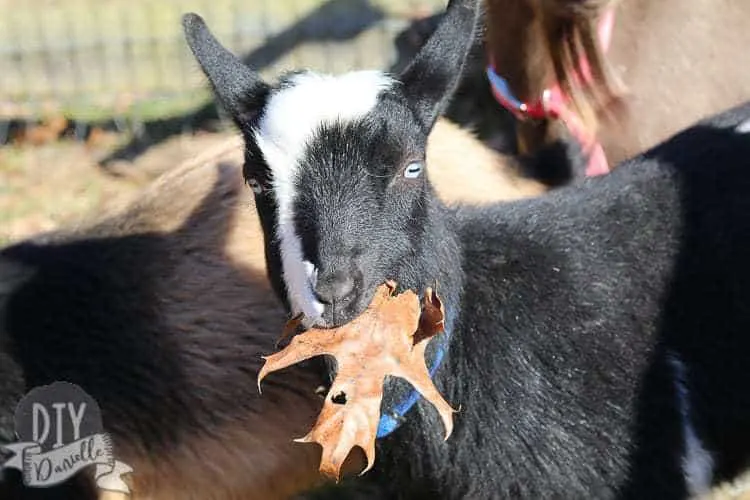
Learning how to milk a goat during the first couple of weeks, as well as thoughts on permaculture and a garden setup for the Spring.
This post contains affiliate links. If you make a purchase with one of these links, I may receive a commission off the sale. This does not impact your price for the product. Thank you.
While this isn’t my typical type of post, I thought it might be interesting to update those of you who follow my blog regularly on our progress at our new home. For those who haven’t been following along on the adventure, we just moved from a 10,000 sq ft property to one that is 8.5 acres. I have a lot of dreams. I’d like to start a horse assisted therapy program once the kids are all in school (aka once the cost of daycare doesn’t make it quite so impossible to work), I want to grow lots of fruits and vegetables for our family, and I love owning farm animals. I’m so excited and it’s hard to know where to start.
To be honest, I feel like a bit of a fraud calling our property a homestead. For one, we live in a pretty suburban area and I am certainly not a veteran gardener or carer of animals. We aren’t living off grid and the local grocery is 5 minutes away… the library is 10. I’m also not hardcore dedicated to organic living… I try to balance the value of my sanity, the need to pay the mortgage, and my concerns about chemicals. I love the taste of organic, naturally raised meat… but I don’t like the price and effort required to obtain it (trying to figure out how to store half a cow in the freezer has been an intimidating prospect).. So I am happy to make an attempt at some small scale homesteading.
We also have three kids, one of whom is 1.5 years old, so all of this stuff needs to be balanced with the reality of children.
So let me explain where we are in our planning. By “we,” I mean me and my husband is so nicely nodding his head and going along for the ride. He’s good to me.
Goats and Milk
I’ve been wanting goats for years. I absolutely adore them. So I did a lot of research and decided that Nigerian Dwarf goats would be a good fit for our property. They’re a bit smaller and therefore produce less milk than some bigger breeds, but I was okay with that. Saanen were a close second because my friend Marie from JustPlainMarie.ca had them and swears they’re the sweetest goats.
Three Benefits to Goats
1. They make milk.
It’s delicious. Only does who have had a baby produce milk and they can produce milk for quite some time after weaning if you continue to milk them consistently. Some people milk once a day, but I am milking twice a day. If I had purchased her baby, I would have only milked once a day and let the baby nurse the other time.
2. They eat brush- they love all of the nasty stuff you probably don’t want to clear on a property.
This is one of the many areas that’s overgrown on our property. The photo doesn’t do it justice, but there were t posts installed forever ago and the wire has started to be overgrown by weeds. This area had already been partially cleared by me. I’m trying to get it cleared away enough around the posts so I can refence the area for the goats to use as a big field.
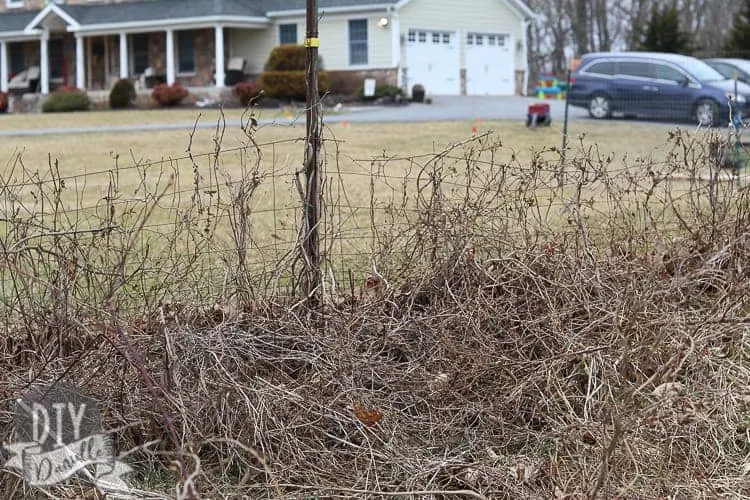
3. They produce compost.
Aka, they poop. One of the things I loved about our ducks was that their poop and bedding made for good compost. I’m looking forward to using the goat’s waste in our garden as well.
Some animal waste is harder or less ideal or unsafe to compost (like dog or cat waste), but goat and duck waste seems to do well.
Goat Realities
1. They’re expensive.
As I was building our goat house, buying supplies (so. many. supplies.), and building a milk stand, I just kept seeing the cost add up. I also bought registered goats (except the wether). NOTHING WAS CHEAP. It was a bit of sticker shock for me because I remembered how cheap ducks seemed when I got them. Whoops.
Now, don’t get me wrong. You can certainly go cheaper than I did. I found good breeders who tested their herd for illnesses. The goats are registered. They have good milking lines. I did this because I would like to continue to have milk which means I’ll need to breed one or both of my does repeatedly over the years of their life. This means babies. And while I could keep every baby, I’ll more than likely want to sell some babies. Healthy, registered babies sell for more money and easier than unregistered.
Also, I think the routine care (excluding medical stuff that comes up) is probably not too bad for goats. It’s the start up and the cost of the goats that’s rough. I think our largest regular expense will actually be bedding… although I expected it to be hay. Bedding adds up quick though!
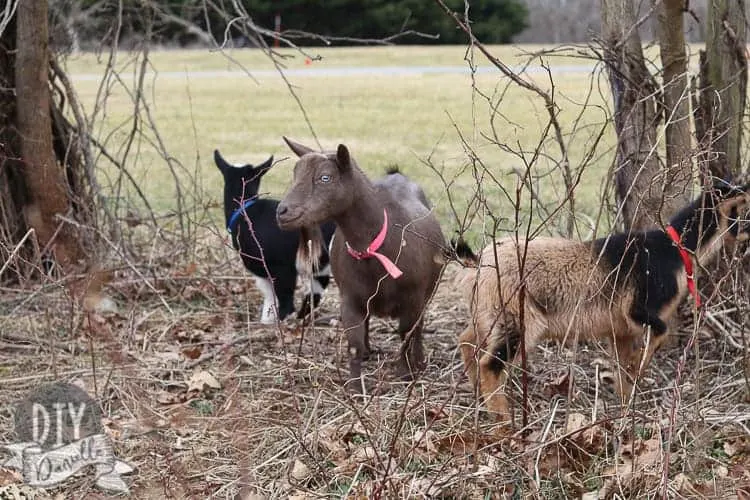
2. Milking is HARD
It’s not as easy as it looks in the movies. Not only that, but it’s not even the SAME as how they do it in the movies. The women who owned the farm were an amazing support to help me learn to milk and care for the goats. They cared that the goats were treated well and that our experience was a positive one. Buy goats from people like this.
Now…I feel like a needy child because milking has NOT gone smoothly. LOL. I had a milking stand ready and have been using it regularly, but Mama Goat is NOT happy with me. I’m not sure if it’s something I’m doing wrong, if she’s testing me, or what, but she’s had a whole host of fun behaviors.
She has:
- Sat like a dog.
- Stuck her foot in the bucket once.
- Attempted to stick her foot in the bucket many many many times.
- Tried to walk off the stand by going OVER the head piece of the milking stand.
- Laid down.
- Kicked the bucket.
- Pooped.
She has been fairly nice about it though and hasn’t kicked me yet. Something that isn’t really out of the realm of possibility.
Even without the behaviors, learning to milk is a challenge. You need to find the right method or you won’t get milk out. Milking uses a set of muscles in your hands that you didn’t even know you had. I have found that massaging my hands is helpful with the soreness as I’m getting used to the process.
My main concern is that I don’t want Mama to get mastitis because I didn’t milk her properly.
Fortunately, we seem to have a settled into a decent routine after 8 days and she’s cooperating now.

3. They’re really cute.
Which makes up for all the hardness if you spend some time with them. It will take time to bond with them so they feel like you’re their herd.
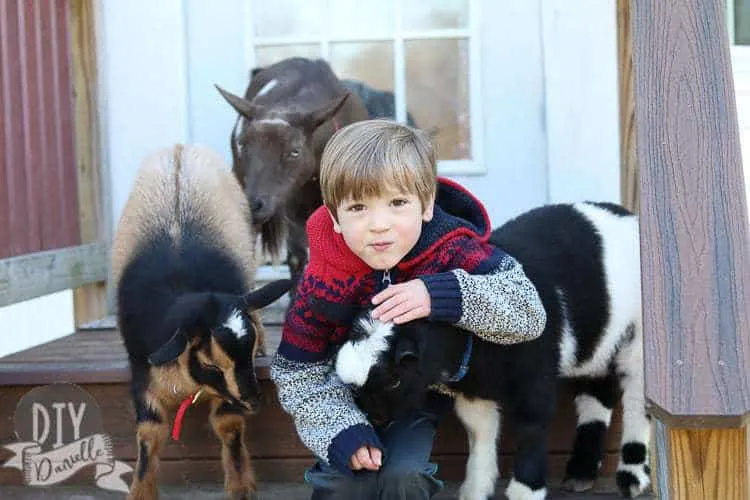
4. Each has their own personality.
Each goat’s personality really does impact how quickly they’ll bond with you. Gender and how they were raised (dam raised vs bottle fed) impact how well this goes. From what I can tell, wethers seem much more cuddly from the beginning. I’ve been told girls just take longer to bond.
The black and white baby is a wether (fixed boy) and he was bottle fed. We could have weaned him, but decided to keep bottle feeding him for a while to help with the bonding process. He has been the most snuggly and easy to bond with though… probably because he’s been bottle raised all along.

5. They’ll pretty quickly adjust to routines.
Ours like to go for little walks with us… they wander so they aren’t 100% trustworthy for a walk around the block, but they will follow us around the yard a bit, snacking on leaves and other things. Some things aren’t safe for them so it’s a good idea to know what areas should be off limits.
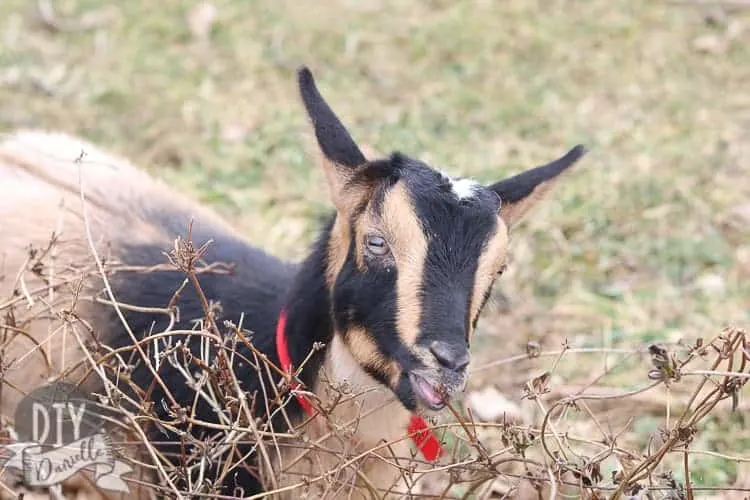
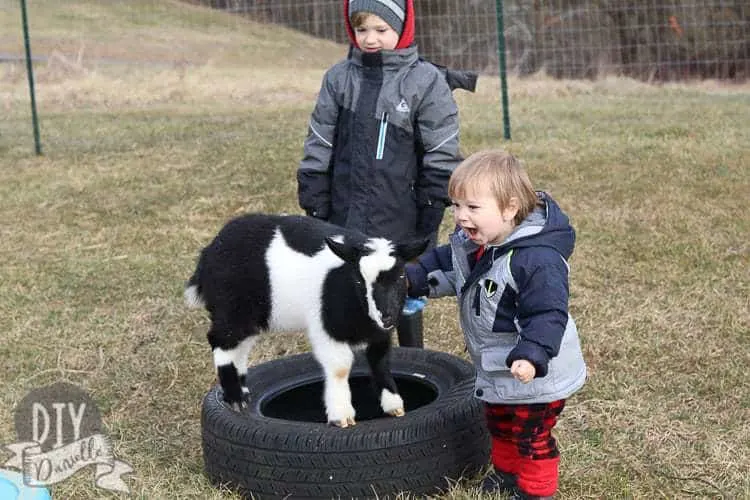
But I’ve been pretty surprised at how quickly they sort of ‘get’ it. It’s only been a week and they pretty much know the deal. We will see how things go long term.
Planning Gardens and Fruit Guilds
The other thing I’ve been working on is planning for spring planting. I’m not a huge gardener, but I’m really interested in fruit and have been listening to the Orchard People podcast, as well as several other permaculture focused podcasts. I read The Fruit Gardener’s Bible last year which I LOVED, as well as Gaia’s Garden. I’d love to do the Beginner’s Course for Fruit Tree Care from Orchard People, but it’s not really in the budget right now.
Honestly, I just need to feed these children who are expensive to feed. We love fruit so it makes sense that I focus on fruit with a lesser focus being put on vegetables.
Setting Up for Composting
Composting is important to me. While I have enjoyed many types of composting, including open bin, closed bin, and worm bin composting, I’m reading Compost Everything: The Good Guide to Extreme Composting right now. I’m enjoying the more relaxed view on it and hope it’ll work well for me this year. I’ve been digging a hole and burying our compost in the front garden for now, seeing I haven’t decided exactly how I want to do this. I don’t want to leave compost uncovered because if the goats eat rotten food, they can get sick.
Currently I’m hoping to get some free loads of wood chips to lay down around the apple and pear trees so I can start forming tree guild garden beds of a course. There’s a site called getchipdrop.com where you can sign up for free loads of wood chips from local arborists, but I’ve heard it’s touch and go on whether you’ll get deliveries. The main thing (we’re guessing) is that your location needs to be more convenient than wherever they normally dump. I’ve heard that you can also contact local arborists or highway departments to see if they offer free chips too.
Fruit Trees
We have several established fruit trees on our property- two apples, one cherry, one pear, and one peach. I’ve been told they all produce fruit so I’m assuming the solo trees all are self pollinating or a neighbor has some trees. Or I’ll find out otherwise when they don’t produce fruit! I’d like to pick up another pear, peach and cherry to ensure fruit, but I am not even sure what kind to get.
Some fruit trees require winter pruning so those- the apples and pear- have been pruned. I did a LOT of pruning.
The peach and cherry tree need to wait to be pruned so I will attack them later.
PRUNING IS FUN! I really enjoyed it. It reminds me of how much fun it was to cut doll hair back when I was a kid- remember how you’d take too much off and eek…? Well the nice thing about fruit tree pruning is that you have the freedom to do quite a bit of pruning for an older tree. It’s very satisfying.
Guilds
I’ve become really interested in setting up guilds around the trees. Rather than traditional orchard style, you have garden beds around the trees and you plant things around the trees that help improve the soil, control pests, and otherwise support the growth of the tree. It’s a neat idea. I love this information from 8thnbee.com about what plants are good for your guild (they have this super useful infographic pin that I can’t find on their site).
Here are the plants I’m interested in trying around our trees. Dandelion works as a fixer, accumulator, and suppressor so I like the idea of encouraging their growth in my garden. White clover is a fixer and a suppressor so it’s also ideal. As you can see, there’s a lot of crossover for plants that work in multiple categories.
Fixers: Chamomile, beans, peas, clover (white clover), dandelion
Accumulators: Chives, garlic, lemon balm, parsley, peppermint, strawberries, dandelion
Suppressors: Chives, oregano, thyme, white clover, dandelion
Mulchers: Strawberry, squash and sweet potato
Repellers: Nasturtium, Chives
Pollinator Plants: Chamomile, chives, dandelion, echinacea, oregano, lavender, lemon balm, milkweed, nasturtiums, peppermint, strawberry, thyme
Gardens
We will use our Garden Tower again this year, but I’m trying to decide on HOW I want to use it. Last year I said I would do just lettuce in this, but I’m afraid I’ll end up with a bunch of lettuce all coming in at the same time. So I may need to think strategically about this and plan accordingly.
The house had four blueberry bushes along one side and I added one more that someone was rehoming on Freecycle back in November. Hopefully it will survive and bloom. I’d like to add some ground cover in our front garden as a living mulch… a living mulch is just a plant that takes over the garden and chokes out your weeds. There’s usually some weeding involved but it’s not as much as if you tried to use regular mulch with lots of gaps between plants.
I’d like to add some grapes, raspberries, hardy kiwi, and currants.
Last year my carrots grew really well in the raised garden beds in front of the hardy kiwi. I’ve never had success with them in the past so I was super excited.
Prepping for Ducks and/or Chickens
We loved having ducks a couple years ago… we had three Muscovy ducks that I rehomed when I was violently sick during my pregnancy with baby #3. Turns out that it wasn’t morning sickness, but rather that egg was triggering vomiting. And by “egg,” I mean anything that had even a tiny bit of egg in it, including most salad dressings, mayo, baked goods, etc. I can’t eat eggs, but I want the benefit of having ducks and/or chickens. I love the compost and they’re excellent at keeping bugs to a minimum. It’s WONDERFUL.
While I love animals, we eat meat and I’d love to have our own “homegrown” meat. There is a huge difference in the taste of meat that is raised organically (and free range) vs. what you buy at the grocery store. I’m guessing a large part of the difference is freshness. It’s just so expensive though that it’s hard to justify it… particularly when it’s touch and go in terms of quality when you buy organic meat at the store.
So I’d like to raise our own meat ducks with possibly a few chickens too. I’ll keep a few ducks for breeding, then butcher (or have someone else butcher) the rest.
I do NOT plan to raise chickens and let them hatch their eggs because I don’t want a rooster… I do not love crowing.
Muscovy ducks are my favorite breed of duck because they’re good for eggs and meat. Apparently their meat tastes similar to red meat, but it’s healthier. They’re also excellent at taking care of bugs and they’re super quiet. They will follow you around making little breathy noises and bob their head at you, but there’s no quacking or clucking or crowing. They’re also quite large. The perfect poultry.
Enjoying Nature
We’ve been exploring the property a bit and there’s a large forest behind us. Here’s a couple of photos from our “nature walk.”
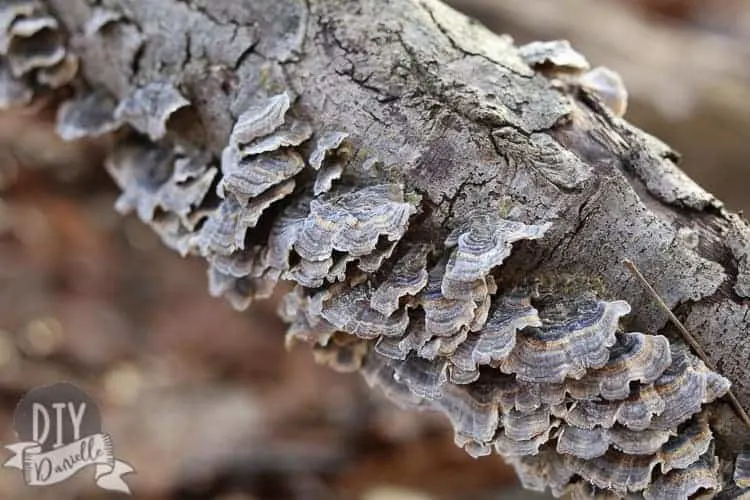

Please pin this post and share it with others!

